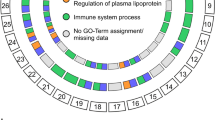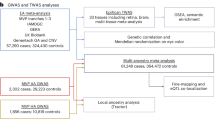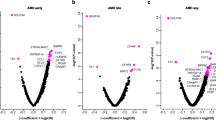Abstract
About 40% of the genetic variance of age-related macular degeneration (AMD) can be explained by a common variation at five common single-nucleotide polymorphisms (SNPs). We evaluated the degree to which these known variants explain the clustering of AMD in a group of densely affected families. We sought to determine whether the actual number of risk alleles at the five variants in densely affected families matched the expected number. Using data from 322 families with AMD, we used a simulation strategy to generate comparison groups of families and determined whether their genetic profile at the known AMD risk loci differed from the observed genetic profile, given the density of disease observed. Overall, the genotypic loads for the five SNPs in the families did not deviate significantly from the genotypic loads predicted by the simulation. However, for a subset of densely affected families, the mean genotypic load in the families was significantly lower than the expected load determined from the simulation. Given that these densely affected families may harbor rare, more penetrant variants for AMD, linkage analyses and resequencing targeting these families may be an effective approach to finding additional implicated genes.
Similar content being viewed by others
Log in or create a free account to read this content
Gain free access to this article, as well as selected content from this journal and more on nature.com
or
References
Friedman DS, O'Colmain BJ, Munoz B et al: Prevalence of age-related macular degeneration in the United States. Arch Ophthalmol 2004; 122: 564–572.
Montezuma SR, Sobrin L, Seddon JM : Review of genetics in age related macular degeneration. Semin Ophthalmol 2007; 22: 229–240.
Klein RJ, Zeiss C, Chew EY et al: Complement factor H polymorphism in age-related macular degeneration. Science 2005; 308: 385–389.
Edwards AO, Ritter III R, Abel KJ, Manning A, Panhuysen C, Farrer LA : Complement factor H polymorphism and age-related macular degeneration. Science 2005; 308: 421–424.
Gold B, Merriam JE, Zernant J et al: Variation in factor B (BF) and complement component 2 (C2) genes is associated with age-related macular degeneration. Nat Genet 2006; 38: 458–462.
Hageman GS, Anderson DH, Johnson LV et al: A common haplotype in the complement regulatory gene factor H (HF1/CFH) predisposes individuals to age-related macular degeneration. Proc Natl Acad Sci USA 2005; 102: 7227–7232.
Haines JL, Hauser MA, Schmidt S et al: Complement factor H variant increases the risk of age-related macular degeneration. Science 2005; 308: 419–421.
Rivera A, Fisher SA, Fritsche LG et al: Hypothetical LOC387715 is a second major susceptibility gene for age-related macular degeneration, contributing independently of complement factor H to disease risk. Hum Mol Genet 2005; 14: 3227–3236.
Haddad S, Chen CA, Santangelo SL, Seddon JM : The genetics of age-related macular degeneration: a review of progress to date. Surv Ophthalmol 2006; 51: 316–363.
Maller J, George S, Purcell S et al: Common variation in three genes, including a noncoding variant in CFH, strongly influences risk of age-related macular degeneration. Nat Genet 2006; 38: 1055–1059.
Seddon JM, Santangelo SL, Book K, Chong S, Cote J : A genomewide scan for age-related macular degeneration provides evidence for linkage to several chromosomal regions. Am J Hum Genet 2003; 73: 780–790.
Seddon JM, Sharma S, Adelman RA : Evaluation of the clinical age-related maculopathy staging system. Ophthalmology 2006; 113: 260–266.
Pearson KLA : On the inheritance of characteristics not capable of exact quantitative measurement. Philos Trans R Soc Lond A 1901; 195: 79–150.
Seddon JM, Cote J, Page WF, Aggen SH, Neale MC : The US twin study of age-related macular degeneration: relative roles of genetic and environmental influences. Arch Ophthalmol 2005; 123: 321–327.
Klein R, Peto T, Bird A, Vannewkirk MR : The epidemiology of age-related macular degeneration. Am J Ophthalmol 2004; 137: 486–495.
Seddon JM, Ajani UA, Sperduto RD et al: Dietary carotenoids, vitamins A, C, and E, and advanced age-related macular degeneration. JAMA 1994; 272: 1413–1420.
Seddon JM, Cote J, Davis N, Rosner B : Progression of age-related macular degeneration: association with body mass index, waist circumference, and waist-hip ratio. Arch Ophthalmol 2003; 121: 785–792.
Acknowledgements
This research was supported by EY16335-02 (National Eye Institute K12 Harvard Vision Clinician Scientist Development Award); EY11309 from the US National Institutes of Health (National Eye Institute RO1 Grant, JMS) ; the Foundation Fighting Blindness; Massachusetts Lions Research Fund, Inc; the Macular Degeneration Research Fund, Ophthalmic Epidemiology and Genetics Service, Tufts Medical Center; and by the Broad Institute Center for Genotyping and Analysis, supported by Grant U54 RR020278 from the NCRR. LS is a recipient of a Research to Prevent Blindness Career Development Award and JMS was a recipient of the Research to Prevent Blindness Lew R Wasserman Award.
Author information
Authors and Affiliations
Corresponding author
Ethics declarations
Competing interests
The authors declare no conflict of interest.
Additional information
Supplementary Information accompanies the paper on European Journal of Human Genetics website (http://www.nature.com/ejhg)
Supplementary information
Rights and permissions
About this article
Cite this article
Sobrin, L., Maller, J., Neale, B. et al. Genetic profile for five common variants associated with age-related macular degeneration in densely affected families: a novel analytic approach. Eur J Hum Genet 18, 496–501 (2010). https://doi.org/10.1038/ejhg.2009.185
Received:
Revised:
Accepted:
Published:
Issue date:
DOI: https://doi.org/10.1038/ejhg.2009.185
Keywords
This article is cited by
-
Genetics and genetic testing for age-related macular degeneration
Eye (2018)
-
Mapping rare, deleterious mutations in Factor H: Association with early onset, drusen burden and lower antigenic levels in familial AMD
Scientific Reports (2016)
-
Genetic mechanisms and age-related macular degeneration: common variants, rare variants, copy number variations, epigenetics, and mitochondrial genetics
Human Genomics (2012)
-
Towards a unifying, systems biology understanding of large-scale cellular death and destruction caused by poorly liganded iron: Parkinson’s, Huntington’s, Alzheimer’s, prions, bactericides, chemical toxicology and others as examples
Archives of Toxicology (2010)



